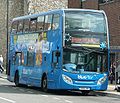Volvo B7TL
This article needs additional citations for verification. (December 2009) |
| Volvo B7TL | |
|---|---|
 | |
| Overview | |
| Manufacturer | Volvo |
| Production | 1999–2007 |
| Body and chassis | |
| Doors | 1 or 2 |
| Floor type | Low floor |
| Powertrain | |
| Engine | Volvo D7C (7.3 L) |
| Power output | 215 hp (160 kW) / 250 hp (186 kW) / 290 hp (216 kW) |
| Transmission | Voith DIWA/ZF Ecomat |
| Chronology | |
| Predecessor | Volvo Olympian |
| Successor | Volvo B9TL (2-Axle) |
The Volvo B7TL is a low-floor double-decker bus chassis which was launched in 1999 and replaced the 2-axle version of the Volvo Olympian (its 3-axle version was replaced by the Volvo Super Olympian). It was built as the British bus operators seemed hesitant to purchase the B7L double decker with a long rear overhang (although some have since entered service in Glasgow, Scotland as 12 m long double deckers).
The B7TL chassis was designed by the Leyland Product Developments consultancy based at the Leyland Technical Centre. It was initially built in Irvine, North Ayrshire, Scotland. In 2000, production was gradually transferred to Sweden. In mid-2004, production of the MkII version of the B7TL was started.
Like the
Orders
United Kingdom
This section needs expansion. You can help by adding to it. (December 2021) |
The Volvo B7TL was highly popular in the United Kingdom, with a large number being purchased by most of the major bus groups such as
The chassis was especially popular in London, with a total of 2,014 Volvo B7TLs being built for London's bus operators, most being bodied with Alexander ALX400, Plaxton President, East Lancs Vyking or Wright Eclipse Gemini bodywork. 790 B7TLs were built for Go-Ahead Group companies London General and London Central, while 378 for Arriva London, 308 for Metroline, 278 for First London and 148 for London United were also built. Transport for London noise regulations would put an end to B7TL orders in 2006, and the type was superseded in London by both the Volvo B9TL and the later Volvo B5LH.[6]
Smaller orders from operators outside London include
The last Volvo B7TLs entered service with First Glasgow with the Wright Eclipse Gemini bodywork in April 2007. [citation needed]
Ireland
Buses built on the B7TL chassis were also popular with Irish operators
South Africa
150 Volvo B7TLs with Marcopolo Viale bodywork were delivered to Metrobus of Johannesburg, South Africa in 2002, alongside an order for 50 Marcopolo bodied Volvo B7R single deck buses. These were the first low-floor buses to enter service in South Africa as part of a major company modernisation scheme.[17]
Gallery
-
Arriva Medway Towns.
-
The unique Volvo B7TL/Alexander Dennis Enviro400 owned by Bluestar. All production Enviro / Volvo buses are on the new B9TL chassis.
See also
- Competitors
- Dennis Trident 2
- Scania OmniDekka
- VDL DB250
References
- ^ "TWM orders Wrightbus deckers for Midlands, Dundee" (Press release). Ballymena: WrightGroup. 9 June 2004. Archived from the original on 11 March 2006. Retrieved 26 December 2021.
- ^ Morris, Stephen (May 2000). "Road Test: Is this the new Olympian?". Buses. Stamford: Key Publishing.
- ^ "Double-deckers go back on city streets". Belfast Telegraph. 26 March 2001. Retrieved 2 February 2023.
- ^ Stanczyk, Sarah (28 January 2003). "Translink Moves Public Transport into Top Gear" (Press release). Belfast: Translink. Archived from the original on 26 June 2003. Retrieved 2 February 2023.
- ^ "Translink orders 200 new buses for NI fleet". The Irish Times. 20 April 2005. Retrieved 2 February 2023.
- ISBN 978-1-52678-695-1. Retrieved 25 December 2021.
- ^ "The First President". Buses. Stamford: Key Publishing. 21 January 2021. Retrieved 17 November 2021.(subscription required)
- ^ "Lothian switches to Volvo/Wrights". Bus & Coach Professional. 1 April 2005. Archived from the original on 24 March 2006. Retrieved 14 April 2022.
- ^ "Lothian orders Euro 3 and Euro 4". Bus & Coach Professional. 7 February 2006. Archived from the original on 24 March 2006. Retrieved 14 April 2022.
- ProQuest 328831312.
Arriva is investing a further £8m on 70 buses in the Yorkshire area of its operations, including 20 low-floor double deck ALX 400 buses, destined for the Leeds guided bus way project.
- ^ Day, James (12 September 2012). "Arriva's uniform bus and coach fleet". Coach & Bus Week. No. 1053. Peterborough: Emap. p. 58. Retrieved 15 July 2022.
- ^ Rowlands, P. (3 September 2004). "Medway Medley". Bus & Coach Professional. No. 87. Retrieved 14 July 2022 – via TRID.
- ^ Brown, Stewart (24 March 2006). "Investing in Merseyside". Bus & Coach Professional. Archived from the original on 24 March 2006. Retrieved 14 July 2022.
- ^ Shipp, Peter (23 April 2001). "EYMS Group announces another big order for new buses" (Press release). Hull: EYMS Group. Archived from the original on 7 July 2001. Retrieved 26 December 2021.
- ^ "East Yorkshire upgrades with Wrightbus" (Press release). Ballymena: WrightGroup. 2 November 2005. Archived from the original on 11 March 2006. Retrieved 26 December 2021.
- ^ "Our Friends over the Irish Sea" (Press release). Blackburn: East Lancashire Coachbuilders. 2004. Archived from the original on 1 April 2004. Retrieved 26 December 2021.
- ^ "New double-deckers for Johannesburg". Bus & Coach Professional. January 2002. Archived from the original on 9 August 2002. Retrieved 7 December 2023.



